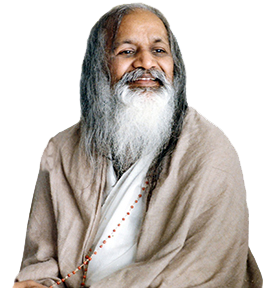

Limbs of Yoga

Maharishi Patanjali's Yoga sutras define Yoga as the complete settling down of the activity of the mind - experiencing the infinite field of pure silence, pure consciousness, the unified field of all the Laws of Nature. He also explains that within the field of eternal silence, the eternal waves of dynamism rise and fall.
Maharishi Patanjali explains that there are eight limbs of Yoga — ashtanga Yoga. These are Yama, Niyam, Asana, Pranayam, Pratyahara, Dharna, Dhyan and Samadhi Of these eight limbs of Yoga,the first five (Yama, Niyam, Asana, Pranayama and Pratyahara) are counted as the outer or external aspects and the remaining three (Dharna, Dhyan, Samadhi) are internal, together called 'Sanyama'.
It had long been misunderstood that the eight limbs of Yoga were eight steps, culminating in Samadhi. Maharishi Mahesh Yogi Ji restored the proper understanding of Yoga such that Samadhi is the basis of all the other 7, and not the other way around. It is only possible to properly and naturally perform actions and have a high moral code of conduct if one is sufficiently grounded in the experience of evenness or samadhi.
About the external five limbs.
1. Yama - Moral code of conduct
Maharishi Patanjali said about Yama - Ahinsasatyasteyabrahmacharyaprigraha Yama:(Yogadarshan Chapter-2 Sutra 30)
The first state of consciousness is waking consciousness, the person expresses his feeling through vaikhari, interacts with each other. Through Yama, one has simple behavior -sattwic, loving, non-violent, devoid of rajas, situated in Brahmiya (unity) consciousness, devoid of all attachments, divine and acceptable.
Yama (moral code) has five aspects : Non-violence, truth, non-stealing, celibacy and non-possessiveness.
2. Niyama - Rules of life for personal conduct
The beliefs, traditions or laws related to ideal behaviour arising from one's mind, senses and physiology are called 'rules'. There are two general types of rules; the laws of nature that regulate, follow, govern, preserve and expand the entire universe and, the other, norms and laws of the family, society and nation in which we live.
Whatever the rules, their purpose is for a successful life. If a person is guided by Natural Law, then all behaviour will be life supporting. Then the Rajas and Tamas will be removed from life and the behaviour and life of the person will be pure, sattwic and divine. When national law is in tune with Natural Law, then society as a whole will be peaceful, prosperous and progressive.
We all know that the fruits of good Karmas are auspicious and the consequences of misdeeds are painful. Doing of good karma is the observance of all good and life-supporting rules.
There are five rules - Purity, Contentment, Austerity, Self-study and Dedication to God.
3. Yogasana or Yogic Postures
Keeping the body in different positions or postures for a certain period of time in a proper sequence according to Yogic procedures is called 'Yogasana'. Maharishi Patanjali defines the proper practice of Yoga asanas as "pleasant steadiness". Today Yogasanas have become popular all over the world but the essential nature and purpose is largely lost. Print, electronic, social and digital media, all are filled with Yogasanas in the name of Yoga. Some scriptural postures and some modern types of exercise have also been included in modern time Yogasanas. The public knows general scriptural Yoga much less and commercial 'Yoga' more. For physical and mental health, the Yogasanas give a lot of relief to the practitioners in the busy part of modern life.
4. Pranayam (Yogic Breathing Exercise)
Prana is the life energy that permeates the entire universe, encompassing all the living and the non-living. It has a close relationship with the air inhaled, but it should not be understood that both are the same. Prana is more subtle than air. Prana is the basic force that permeates the air and all the universe. It is the subtlest form of that energy.
The general sense is that life is governed by inhaling and exhaling breath. The common man does not understand anything else. The importance of Pranayam is that we organise and increase our vitality by practice of Pranayam.
Differentiating the time period between the practitioner's normal in or out breathing action, is controlled through Pranayama. The definition of Pranayam makes it clear that "Pranayam is the name for controlling one's life force". Poorak is-air pulling inside. Rechak is leaving the air out. Holding the air inside the body for some time is the Kumbhak. There are many types of Poorak, Rechak and Kumbhak.
We stabilize the mind with Pranayam-Yogic Breathing Exercises and then prepare to go into a state of perception through Pratyahar.
Together Yogasanas and Pranayama are excellent ways to then start meditation.
5. Pratyahar (Withdrawal of Senses)
Pratyahar is the name of withdrawing one's attention from the fields of senses and thoughts. Through Yama, Niyam, Asan, Pranayama, there is a kind of peace of physical activity, the activities start to slow and balance. The mind, gradually starts to become inner-directed, without attachment. Then the senses no longer incline towards outer world and become attuned , beyond them, beginning the inward experience of silence and peace - this is Pratyahar.
No training is required for Pratyahar-withdrawal. After Yama, Niyam, Life organized and disciplined in routine with Yama and Niyam, after practicing Yoga and Pranayam, when we proceed for Meditation, the Pratyahar itself comes into application.
6. Dharna (Transition between Pratyahar and Meditation)
The three inner branches of Yoga are Dharna, Dhyan and Samadhi. These three together are called Sanyama. In Pratyahar, the last stop of the external practice, the senses separate from the behavior of the outside world and begin to become inner directed. Then through the practice of Transcendental Meditation the mind begins to settle - is unified rather than scattered .
7. Dhyan (Meditating or Transcending)
As the mind settles, it naturally begins to transcend. Transcendental Meditation uses this natural tendency of the mind to transcend as it basis. The result if a simple effortless technique.
Maharishi Mahesh Yogi Ji has brought the knowledge of Ashtang Yoga in every corner of India and then hoisted the flag of Yoga in more than 100 nations all over the world starting from 1956. Maharishi Ji gave millions of people the experience of Meditating and Transcending through the technique of Transcendental Meditation (TM) and gifted many beneficial effects, which are described by Maharishi Patanjali and many other Maharishies.
Transcendental Meditation became very popular and acceptable in the whole world, because this technique requires no effort and was very simple to learn and practice. A person of any religion, caste, class, gender, faith or belief can learn this simple process of Meditation and can gain many benefits by practicing it for a lifetime.
8. Samadhi (Unified Consciousness)
In the correct practice of meditation, the consciousness begins to enjoy its quieter values, ultimately bringing complete settling, complete peace - samadhi. In that state, only pure, blissful awareness remains.
There is complete absence of all senses, action, desires, thoughts, disorders. Only the soul knows the soul, it wanders in itself, it stays in itself.
This is the situation of Absolute Bliss-Chidananda, Paramananda, Atmanand, Bhagavadanand, union of God with Soul. This is the situation when the individual becomes cosmic - Brahm. It is the state of "Ayamatma Brahma", "Aham Brahmsasmi". I am the Brahma-I am the totality. With regular practice of meditation, this unbounded blissful state of awareness does not leave - even while engaging in the world. With this state comes the attainment of Siddhis.
This field of Samatva Yoga-Unified Field is the home of all knowledge, all laws of nature, all possibilities. Maharishi ji has introduced TM-Siddhi Programme based on Patanjali Yoga Sutras to accelerate the growth of awareness to this supreme level. This area of Samatva Yoga-Unified Field, this is field also where all Devatas reside. This is that level which is the source of all Siddhis-the latent potential of human life. Richo Akshara Parme Vyaman, Yasmin Deva Adhi Vishve Nisheeduhu-Rik Veda.
